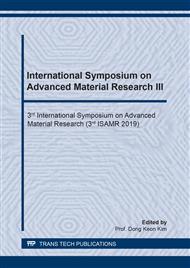[1]
E.V. Korolev, Problems and prospects of nanotechnology in construction, Proceedings of KazGASU. 2 (2011) 200-208.
Google Scholar
[2]
M.D. Balmakov, Yu.V. Puharenko, Nanocomposite materials science, Bulletin of civil engineers. 3 (2005) 53–57.
Google Scholar
[3]
Yu.V. Puharenko, D.I. Ryzhov, On the effect of carbon fulleroid nanoparticles on heat dissipation of cement paste, Bulletin of civil engineers.4 (2013) 156–161.
Google Scholar
[4]
V.I. Loganina, O.A. Davydova, Izvestkovye finishing compositions based on the sol-gel technology, Stroitel'nye Materialy. 3 (2009) 50-51.
Google Scholar
[5]
P. Greenwood, Modified silica sols: titania dispersants and co-binders for silicate paints. Pigment&Resintechnology. 39 (6) (2010) 315-321.
DOI: 10.1108/03699421011085803
Google Scholar
[6]
P.Ailer, Chemistry of silica. Moscow, World, (1982).
Google Scholar
[7]
A.A. Gulyaev, A.M. Nepomiluev, K.G. Zemlyanoy. RU Patent 2 272 820 (2006).
Google Scholar
[8]
V.I. Loganina, S.N. Kislitsyna, Y.B. Mazhitov, Structure and Properties of the Modified Binding for Silicate Paints, Materials Science Forum. 931 (2018) 469-474.
DOI: 10.4028/www.scientific.net/msf.931.469
Google Scholar
[9]
V.I. Loganina, Y.B. Mazhitov, Research of inter-phase interaction in ZOL-silicate paints, International Journal of Engineering & Technology 7 (4.5) (2018) 605-607.
Google Scholar
[10]
A.I. Bykhovsky, Spreading. Naukova Dumka, Kiev, (1983).
Google Scholar
[11]
V.I. Loganina, I.A. Averin, Y.B. Mazhitov, A.A. Karmanov, Composition of the polysilicate binder for silicate paints, Academic Bulletin URALNIIproekt RAASN. 4 (2017) 69-72.
Google Scholar


